Resources
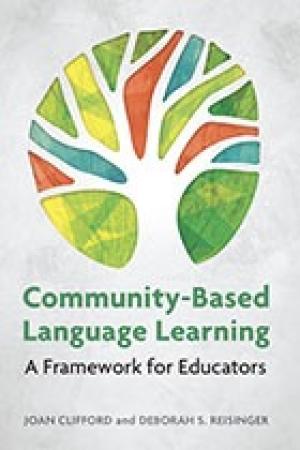
Can we escape political injustice when we learn a language? Most people would say that language and justice issues are separate, but according to this book’s authors, Joan Clifford and Deborah Reisinger, learning another language cannot be completed by simply gaining a linguistic skill in a classroom. They reason that language learners cannot overlook the diverse cultural and social factors of those who live in their own language community. Therefore, the book introduces the importance of local community-based learning for second-language learners (CBLL, as the authors abbreviate) to build a better educational framework. Specifically, Clifford and Reisinger, US-based language professors, pay attention to the unique experiences of second-language student learners with relation to their local communities in America. As described in Chapter Four, speaking the dominant language in a society gives one access to the society’s dominant culture. For example, in the United States, English holds such a power. The problem is that “not all ways of speaking English are created equal in certain social spaces” (101). On the surface, second-language English speakers seem unimpeded in their access to America’s educational and health services, but actually their different accents and cultures are often undervalued “in the school system which prizes and reproduces dominant (white, English-speaking) culture” (101). That is, for second-language learners, where their living language communities are located, economically, socially, and politically, matters when they try to access America’s dominant cultural group. Although Clifford and Reisinger focus on the American learning situation and social injustice issues, their audience is not limited to American educators. Rather, by providing a better local community-based learning model, the authors hope that students will critically reflect and challenge problems which are imbued in their social structures. Regarding this, the book is not only useful for learning foreign language but also for other areas such as the missionary context where theological subjects are taught in English or in other languages. Further, within this emphasis on local communities as a learning partner, for both students and teachers, learning another language allows students to encounter something more than language. That is, it can be a place for the students to experience a “dissonance” between their previous beliefs about their own community’s problems, and those that appear through CBLL conversation. For the teachers as well, this conversation offers a chance to reconsider their cultural privilege and power, and how this might affect their students who come from diverse communities. Finally, the book means to create “brave spaces” for “genuine dialogue” between learners, educators, and communities by coping with their conflicts or tensions to deeply understand and challenge social injustice issues (140). To do this, the book structures each chapter with reflections for instructors and activities for students to provide a practical framework of CBLL. This book would be valuable for both educators and their students who are considering their communities as important learning partners with relation to their own ecclesial, social, and cultural context.
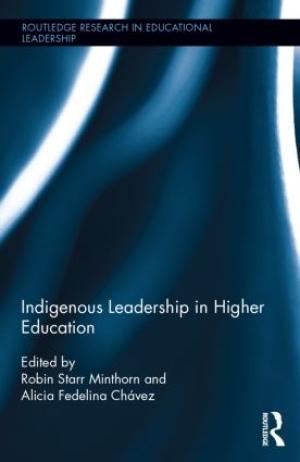
Excellence is seldom achieved alone. These words express one of the major themes of Indigenous Leadership in Higher Education, edited by Robin Starr Minthorn and Alicia Fedelina Chávez. Consisting of autobiographical narratives, the editors and contributors weave a blanket of experiences and guiding principles which illustrate and encourage the involvement of Indigenous leaders throughout the academy. Many of the narratives begin in the traditional manner with the authors situating themselves within their maternal and paternal lines, recognizing the interconnectedness of the present to the past in order to lead future generations well. That sense of community permeates the various narratives, weaving a thread into the blanket of colors that blends the experiences and insights into what constitutes Indigenous leadership. This blend of narratives is most evident in the second and the final chapters, in which the editors succinctly gather individual contributors’ words and correlate them to particular themes that serve as a wheel of knowledge in chapter two and summarize potential methods for incorporation into higher education in the final chapter. In chapter two, “Collected Insights,” the editors provide a wheel of four major components of what constitutes Indigenous leadership. The last chapter highlights approaches and philosophies, strategies, academics, and means of working with students to promote and encourage leadership for Indigenous peoples. While it may be tempting to read just these two chapters because of the breadth contained therein, the narratives themselves expand on one or more of the dimensions discussed in these two chapters. One of the major themes is that Indigenous leadership is communal rather than a solo endeavor; Bryan McKinley Jones Brayboy writes that “Indigenous leadership requires individuals to see themselves as part of a unified whole” (53). In chapter two, the editors provide other examples that demonstrate the importance of connection to the community through its elders and the people for whom one serves. Even though most of the narratives are directed toward Indigenous leadership in higher education, many of the principles can be applied to all persons in the academy. The narratives help educators rethink how to provide opportunities for all students to grow in wholeness and wisdom, not just knowledge of facts. Among the qualities the editors describe as “what we strive to embody,” (17) qualities that may resonate with all Indigenous persons, for me, one is clearly lacking. As a Native Hawaiian, I would include gratefulness. While this quality may be imbedded in the concepts of generosity, humility with confidence, and spirituality, I found few expressions of gratitude within the narratives. This disconcerted me because it is inconsistent with what I learned from my kupuna, my Elders. I would hope that, while this embodiment is not expressly evident in the narratives, it is part of their respect for the Elders who have wrapped them in the blankets of experience and provided them with the warmth that enabled them to be Indigenous leaders.
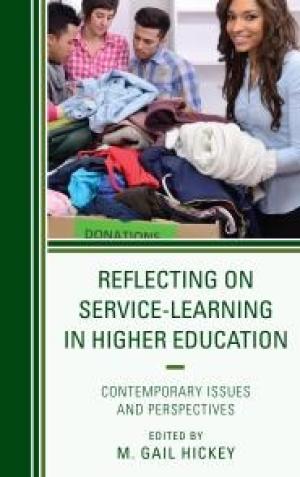
M. Gail Hickey has gathered together a valuable resource in Reflecting on Service-Learning in Higher Education. The chapters provide a vast collection of best practices and important principles to consider when engaging students in academic service-learning. The book is divided into three sections focusing on different perspectives for reflection: Community Partnerships, Classroom Practice, and Diversity. Although the first section is titled “Reflection on Community Partnerships,” it is really more a reflection on institutional commitment to building community partnerships. The section has two provocative chapters that take the reader through a reflection on just what impact an educational institution should have within its surrounding community and how service-learning can help the institution attend to the voices of the community in which it is placed. Sherrie Steiner’s principles for implementing reciprocity provide a great framework for institutions and faculty to consider while developing service-learning curriculums. Joe D. Nichols asks important questions about the focus on research and specialization at the expense of community and civic engagement and draws from multiple sources to foster reflection around alternatives to faculty recognition of such public work. “Reflecting on Classroom Practice” is the second and largest section of the book. Each chapter offers a perspective on how service-learning has worked in a particular context. This collection of cases from fields as varied as education, sociology, fine arts, and dental hygiene offers a myriad of suggestions for how to structure a curriculum that incorporates service-learning. There are suggested rubrics, logistical considerations, a solid bibliography with each chapter, and suggestions for what worked well and how one might improve the process over time. Readers will find this section full of ideas, suggestions, and methods focused on building a curriculum, partnering with community members, and methods for reflection with students. The final section, “Reflecting on Diversity,” pushes even further into the questions that come up when students engage in service-learning with diverse communities. Here the case studies offer insights into how students perceive and articulate the impact of their service-learning on their growing sense of their own contextual lenses and the lenses of those with whom they work. Faculty and administrators are invited to anticipate the types of responses their own students will have in an effort to foster positive reflection and growth in the students that is fruitful for the partner communities as well. One concern with the book is that community partners are not represented as writers of the chapters. The effort to shed light on the importance of effective community partnerships and the responsibility of higher education institutions to develop service-learning curriculum in partnership with the surrounding community is important. The inclusion of the voices of partner communities as authors could have added to the depth of the book. Reflecting on Service-Learning in Higher Education is a resource that will be appreciated by high school and university faculty and administrators. The questions raised and the suggestions shared will be useful for any institution looking to begin or strengthen their commitment to service-learning in higher education. Institutions, faculty, students, and the communities with which they partner will all benefit from M. Gail Hickey’s invitation to reflect.
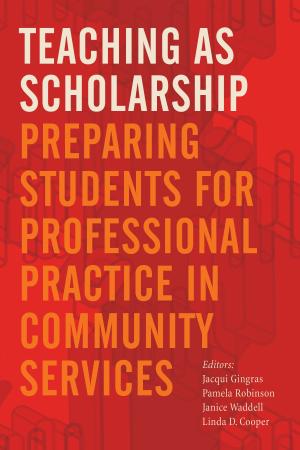
This book brings together faculty reflections on pedagogy and inter-professional collaboration from a broad range of disciplines within a single institution in Toronto: Ryerson University. While a single institution may appear to provide only a limited contextual perspective, the nature of the varied disciplines represented here provides a diverse set of resources, drawing from early childhood studies, nursing, disability studies, social work, sociology, city planning, and midwifery. Though the fields of theology and religion are not represented among the contributors, educators in theological and religious education will resonate with the need to better equip students for inter-professional engagement. Though all contributors are from the same institution, the commonality or coherence among chapters ends with the institutional affiliation of the authors. The editors note the book’s lack of coherence, and justify this by saying that the “frontiers” of community-services-related learning “are not neat, formulaic, or easy to navigate” (5). For this reason, reading this text cover-to-cover can be a disappointment, since the chapters are not of equal quality, nor do they create any obvious structure or overall argument. That said, there are gems in particular contributions for those interested in learning about teaching techniques and reflections that draw from critical pedagogies and integrative approaches, bringing the best of new theories in education. For instance, in “Drawing Close: Critical Nurturing as Pedagogical Practice,” authors May Friedman and Jennifer Poole bring together insights from Indigenous studies, Black feminist thought, maternal pedagogies, and mad studies to argue for a way of being in the classroom that promotes a nurturing relationship between student and teacher, challenging the Enlightenment and Western ideals of independence as a goal of education. These authors call for a suspension on neoliberal concerns for risk and lack of efficiency, instead arguing that an interdependence approach requires the risk of blurring the distinction between teachers and students (96). If a reader of this book were to choose one chapter to read from among the many contributions, this would be the chapter to focus on, and the bibliography provides additional resources to pursue. Other chapters included interesting suggestions and interventions in education, such as “Educating for Social Action among Future Health Care Professionals” which focused on a learner-centered model for course creation. This chapter includes appendices for how the authors Jacqui Gingras and Erin Rudolph were able to craft a course with considerable input from students regarding course themes, which assignments they would have to complete, and what grading rubrics would entail. Other chapters (3, 8) draw from narrative theory and describe the way students are taught to listen to the narratives of clients as well as to their own personal narratives. While this book’s chapters are not equally helpful, the insights available in a few choice chapters are worth the read.
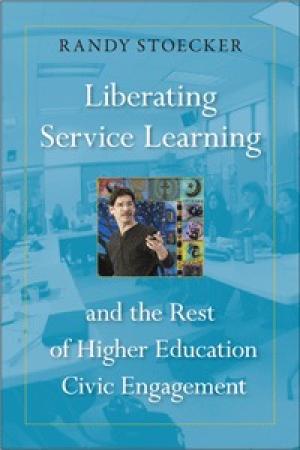
The double entendre in this book’s title may be clichéd but it is often apt, and in this case Randy Stoecker makes a strong argument that service learning and the rest of higher education civic engagement (“service learning” functions as a catch-all term) is in need of liberating so that it can be liberating. Stoecker accuses “institutionalized service learning” (ISL), as he calls the prevailing practice, of reinforcing an oppressive neoliberal political-economic order. As a faculty member of the University of Wisconsin, he speaks from experience. What keeps most service-learning practitioners captive, Stoecker asserts, is a failure to theorize about how service learning does and/or could operate. He offers a theoretical view that enables him to (1) reflect on and criticize ideas in current practice and (2) project alternative ideas as points of articulation for liberating service learning – in both senses alluded to above. Stoecker develops his vision in twelve chapters divided into three parts. A “prelude,” “interlude,” and “postlude” provide other vantage points, ironizing Stoecker’s implied authority on the matters at stake and illustrating metaphorically the problems and promises of service learning. An index of names and topics is also provided. Part I, “The Problem and Its Context,” surveys the current state of ISL. In chapter 1, beginning with a critical incident from September 2013 – a disciplinary hearing for students who, in support of labor unionization efforts at the University of Wisconsin, occupied the Chancellor’s office – Stoecker explicates his worries about who ISL truly serves. In chapter 2 he recounts the emergence and eventual institutionalization of service learning in U.S. colleges and universities from the late nineteenth to early twenty-first century, emphasizing evidence that suggests ISL has come to serve bureaucratic requirements rather than community initiatives. Chapter 3 makes a preliminary analysis of the avowed and actual theoretical commitments of current practice, pointing to a need for sustained examination of the meaning of four core concepts: learning, service, community, and change. Part II deepens the analysis. The author argues that ISL supposes “learning” is for students to accrue from service. “Service,” then, means charitable giving, rather than helping communities learn how they might wield their own power. So concepts of “community” in ISL neglect political-economic issues of structural injustice. Accordingly, “change” comes to be seen as a matter of advancing individuals within an unquestioned neoliberal order. Part III re-envisions the core concepts. The crucial move is to start with a critical theory of “change” as social change. In this light “community” may be grasped not as a vague given but as a goal; “service”is seen not as charity but as casting our lot together to form community and effect change; and “learning” means learning to be learners in service to a shared struggle for change – in short, learning to be liberated. Although Stoecker offers something to annoy everyone, I still recommend Liberating Service Learning for its challenging examination of the spirit of service learning, in its present state and as it might be in future.
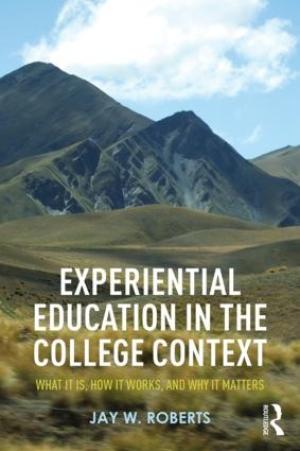
Experiential Education in the College Context provides a useful introduction to both the theoretical underpinnings and the practical application of experiential education. Roberts, Associate Vice President of Academic Affairs and Director of the Center for Integrated Learning at Earlham College, writes out of his experience as a faculty member, administrator, and philosopher of education. His volume is well-equipped as a guide for leaders in higher education interested in “harnessing the power of the live encounter between students and teachers” (xi). Roberts divides the volume into two main sections, the first covering theoretical aspects of experiential education and the second exploring its practical facets. Each section is comprised of four chapters. Chapter one introduces the reader to the current educational landscape, noting that it is not merely a time of “disruption and destabilization,” but a time of “tremendous opportunity” (18). Chapter two defines experiential education, teasing out some of its many implications through three curriculum models. In chapter three, Roberts sorts experiential education models into “four core methodologies”: active learning, community-based learning, integrative learning, and problem and project-based learning (63). Chapter four identifies models such as the seat paradigm and the teacher as expert paradigm that educators should leave behind as they embrace an experiential approach. In chapters five through eight, Roberts shifts to the practical application of the theoretical principles discussed in the first half of the book. Chapter five considers design, chapter six facilitation, chapter seven assessment, and chapter eight the integration of experiential education in the college classroom and across the campus. Finally, the Afterword places experiential education in the wider world of the academy, and an Appendix offers a reference list for a variety of experiential education programs. My one critique – and it is a small one – of Roberts’s work is that he quotes too many secondary scholars at length. Block quotes fill the pages and definitions abound. The volume would have been infinitely more accessible had he compiled the many definitions in a glossary in the back of the volume and confined his extensive dialogue with other scholars to the footnotes. Still, Roberts’s volume provides rich descriptions of the variety of practices that fit under the experiential education umbrella and offers useful examples for incorporating these models in the classroom. In short, the text offers a fine introductory resource. Roberts wrote this book “for students who wish to learn more about the theoretical concepts behind the approach, for faculty who might be interested in what experiential education looks like in practice, and for administrators trying to respond programmatically and creatively to a rapidly changing landscape in higher education” (xi). While I am not convinced that many students will wade through its theoretical waters, the volume does address the needs of faculty and administrators investigating the possibilities that experiential education offers. I will carry Roberts’s image of “teachers as curators of experience” rather than “content providers” with me for a long time (81).